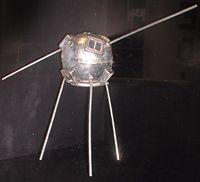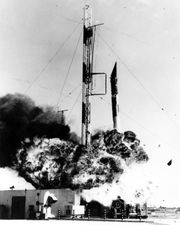Project Vanguard
2008/9 Schools Wikipedia Selection. Related subjects: Space transport
Project Vanguard was a program managed by the United States Naval Research Laboratory (NRL), which intended to launch the first artificial satellite into Earth orbit using a Vanguard rocket as the launch vehicle.
In response to the surprise launch of Sputnik 1 on October 4, 1957, the U.S. restarted the Explorer program, which had been proposed earlier by the Army Ballistic Missile Agency (ABMA). Together with the Jet Propulsion Laboratory (JPL), ABMA built Explorer 1 in 84 days and launched it on January 31, 1958. Before work was completed, however, the Soviet Union launched a second satellite, Sputnik 2, on November 3, 1957. Meanwhile the spectacular televised failure of Vanguard TV3 on December 6, 1957 deepened American dismay over the country's position in the Space Race.
On March 17, 1958, Vanguard 1 became the second artificial satellite successfully placed in Earth orbit by the United States. It was the first solar-powered satellite. Just 152 mm (6 in) in diameter and weighing just 1.4 kg (3 lb), Vanguard I was described by then- Soviet Premier Nikita Khrushchev as, "The grapefruit satellite."
Vanguard 1 is the oldest artificial satellite still in space. Vanguard's predecessors, Sputnik 1, Sputnik 2 and Explorer 1 have fallen out of orbit.
Project history
As part of planning for the International Geophysical Year (1957–1958), the U.S. publicly undertook to place an artificial satellite with a scientific experiment into orbit around the Earth.
The three services' proposals
Proposals to do this were presented by the United States Air Force, the United States Army, and the United States Navy. The Army Ballistic Missile Agency (ABMA) under Dr. Wernher von Braun had suggested using a modified Redstone rocket (see: Juno I) while the Air Force had proposed using the Atlas rocket, which did not yet exist. The Navy proposed designing a rocket system based on the Viking and Aerobee rocket systems, for the purposes of launching the first US satellite.
The Air Force proposal was not seriously considered, as Atlas development was years behind the other vehicles. Among other limitations, the Army submission focused on the vehicle, while a payload was assumed to become available from JPL, and the network of ground tracking stations was assumed to be a Navy project. Meanwhile, the NRL proposal detailed all three aspects of the mission.
In August 1955, the DOD Committee on Special Capabilities chose the Navy's proposal as it appeared most likely, by spring 1958, to fulfill the following:
- 1) place a satellite in orbit during the IGY
- 2) accomplish a scientific experiment in orbit
- 3) track the satellite and ensure its attainment of orbit
Another consideration was that the Navy proposal used civilian sounding rockets rather than military missiles, which were considered inappropriate for peaceful scientific exploration. What went unstated at the time was that the US already had a covert satellite program underway, WS-117, which was developing the ability to launch spy satellites using USAF Thor IRBMs. The US government was concerned that the Soviets would object to military satellites overflying the Soviet Union as they had to many aircraft incursions and the balloons of the Genetrix project. The idea was that if a clearly "civilian" and 'scientific' satellite went up first, the Soviets might not object, and thus the precedent would be established that 'space' was above national boundaries.
Designated Project Vanguard, the program was placed under Navy management and DoD monitorship. The Naval Research Laboratory (NRL) in Washington was given overall responsibility, while initial funding came from the National Science Foundation. The director was John P. Hagen (1908–1990), an astronomer who in 1958 would become the assistant director of space flight development with the formation of NASA . The initial 1.4 kg spherical Vanguard satellites (designated "Test Vehicles" prior to launch) were built at the NRL, and contained as their payload seven mercury cell batteries in a hermetically sealed container, two tracking radio transmitters, a temperature sensitive crystal, and six clusters of solar cells on the surface of the sphere.
NRL was also responsible for developing the launch vehicles, developing and installing the satellite tracking system, and designing, constructing, and testing the satellites. The tracking system was called Minitrack. The Minitrack stations, designed by NRL but subcontracted to the Army Corps of Engineers, were along a North-South line running along the east coast of North America and the west coast of South America. Minitrack was the forerunner of another NRL-developed system called NAVSPASUR, which remains operational today under the control of the Air Force and is a major producer of spacecraft tracking data.
Sputnik and Explorer 1
On October 4, 1957, the Vanguard team learned of the launch of Sputnik 1 by the USSR while still working on a test vehicle (TV-2) designed to test the first stage of their launcher rocket. After the Soviet Union launched Sputnik 2, on November 3, 1957, then Secretary of Defense Neil H. McElroy directed the Army to use the Juno I and launch a satellite. At 11:45 AM on December 6, an attempt was made to launch TV-3. The rocket rose about four feet (1.2 m) into the air when the engine injectors failed. Deprived of its thrust the rocket immediately sank back down to the launch pad and exploded. The payload nosecone detached in the process and landed free of the exploding rocket. The satellite was too damaged for further use; it now resides in the National Air and Space Museum. On February 1, 1958, the ABMA managed to launch the Explorer 1 satellite.
On March 17, 1958, the program successfully launched the Vanguard satellite TV-4. TV-4 achieved a stable orbit with an apogee of 3,969 kilometers (2466 mi) and a perigee of 650 kilometers (404 mi); it was estimated that it would remain in orbit for 240 years, and Vanguard 1 remains the oldest human-made satellite still in orbit at this time. The radio continued to transmit until 1964, and tracking data obtained with this satellite revealed that Earth is not quite a perfect sphere - it is elevated at the North Pole and flattened at the South Pole. The Vanguard program was transferred to NASA when that agency was created in mid-1958. The program ended with the launch of Vanguard 3 in 1959.
In late 1958, with responsibility for Project Vanguard having been transferred to NASA, the nucleus of the Goddard Space Flight Centre was formed. After the transfer, NRL rebuilt their spacecraft technology capability and have developed some 87 satellites over the past 40 years for the Navy, DoD and NASA.
Accomplishments
Vanguard met 100 percent of its scientific objectives, providing a wealth of information on the size and shape of the Earth, air density, temperature ranges, and micrometeorite impact. It demonstrated that the Earth is slightly pear-shaped, not perfectly round; corrected ideas about the atmosphere's density at high altitudes and improved the accuracy of world maps.
NRL space scientists say that the Vanguard 1 program introduced much of the technology that has since been applied in later U.S. satellite programs, from rocket launching to satellite tracking. For example, it validated in flight that solar cells could be used for several years to power radio transmitters. Vanguard's solar cells operated for about seven years, while conventional batteries used to power another on-board transmitter lasted only 20 days.
Although Vanguard's solar-powered "voice" became silent in 1964, it continues to serve the scientific community. Ground-based optical tracking of the now-inert Vanguards continues to provide information about the effects of the Sun, Moon and atmosphere on satellite orbits. Vanguard I marked its 49th year in space on March 17, 2007. In the years following its launch, the small satellite has made more than 178,061 revolutions of the Earth and traveled over 9.4 billion kilometers (5.1 billion nautical miles).
The Vanguard Satellite Launch Vehicle (the term was invented for the operation SLV models, as opposed to the Test Vehicle TV versions) of the first generation. It was a much smaller and lighter launcher than the Jupiter-C (Redstone) which launched the Explorer satellites, or the immense R-7 that the Soviets used to launch the early Sputniks.
Launch history
- Test vehicle launches
The first Vanguard flight, a successful suborbital test of the TV-0 single-stage vehicle, was launched on December 8 1956. On May 1, 1957, the two-stage test vehicle TV-1 was successfully launched. Vanguard TV-2, another suborbital test, was launched October 23, 1957.
The Vanguard rocket launched three satellites out of eleven launch attempts:
- Vanguard TV3 - December 6, 1957 - Failed to orbit 1.36 kg (3 lb) satellite
- Vanguard TV3 Backup - February 5, 1958 - Failed to orbit 1.36 kg (3 lb) satellite
- Vanguard 1 - March 17, 1958 - Orbited 1.47 kg (3.25 lb) satellite
- Vanguard TV5 - April 28, 1958 - Failed to orbit 9.98 kg (22 lb) satellite
- Vanguard SLV 1 - May 27, 1958 - Failed to orbit 9.98 kg (22 lb) satellite
- Vanguard SLV 2 - June 26, 1958 - Failed to orbit 9.98 kg (22 lb) satellite
- Vanguard SLV 3 - September 26, 1958 - Failed to orbit 9.98 kg (22 lb) satellite
- Vanguard 2 - February 17, 1959 - Orbited 10.8 kg (23.7 lb) satellite
- Vanguard SLV 5 - April 13, 1959 - Failed to orbit 10.3 kg (22 lb 11 oz) satellite
- Vanguard SLV 6 - June 22, 1959 - Failed to orbit 10.3 kg (22 lb 11 oz) satellite
- Vanguard 3 - September 18, 1959 - Orbited 22.7 kg (50 lb) satellite


